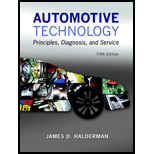
Automotive Technology: Principles, Diagnosis, and Service (5th Edition)
5th Edition
ISBN: 9780133994612
Author: James D. Halderman
Publisher: PEARSON
expand_more
expand_more
format_list_bulleted
Concept explainers
Question
Chapter 11, Problem 5CQ
To determine
The areas that are commonly damaged when hoisting a vehicle.
Expert Solution & Answer
Want to see the full answer?
Check out a sample textbook solution
Students have asked these similar questions
Consider 0.65 kg of N2 at 300 K, 1 bar contained in a rigid tank connected by a valve to another rigid tank holding 0.3 kg of CO2 at 300
K, 1 bar. The valve is opened and gases are allowed to mix, achieving an equilibrium state at 290 K.
Determine:
(a) the volume of each tank, in m³.
(b) the final pressure, in bar.
(c) the magnitude of the heat transfer to or from the gases during the process, in kJ.
(d) the entropy change of each gas and of the overall system, in kJ/K.
A gas mixture with a molar analysis of 40% CH4 (methane) and 60% air enters a control volume operating at steady state at location 1
with a mass flow rate of 5 kg/min, as shown in the figure below. Air enters as a separate stream at 2 and dilutes the mixture. A single
stream exits with a mole fraction of methane of 5%. Assume air has a molar analysis of 21% O2 and 79% N2.
(CH4, Air)
m₁ =
= 5 kg/min
Air
(21% O2, 79% N₂)
3
+
(5% CH4, 95% Air)
A gas mixture with a molar analysis of 40% CH4 (methane) and 60% air enters a control volume operating at steady state at location 1
with a mass flow rate of 5 kg/min, as shown in the figure below. Air enters as a separate stream at 2 and dilutes the mixture. A single
stream exits with a mole fraction of methane of 5%. Assume air has a molar analysis of 21% O2 and 79% N2.
(CH4, Air)
m₁ =
= 5 kg/min
Air
(21% O2, 79% N₂)
3
+
(5% CH4, 95% Air)
Chapter 11 Solutions
Automotive Technology: Principles, Diagnosis, and Service (5th Edition)
Ch. 11 - Why must safety stands be used after lifting a...Ch. 11 - What precautions should be adhered to when storing...Ch. 11 - What precautions should be adhered to when...Ch. 11 - Prob. 1CQCh. 11 - Prob. 2CQCh. 11 - Prob. 3CQCh. 11 - Prob. 4CQCh. 11 - Prob. 5CQCh. 11 - Prob. 6CQCh. 11 - Prob. 7CQ
Knowledge Booster
Learn more about
Need a deep-dive on the concept behind this application? Look no further. Learn more about this topic, mechanical-engineering and related others by exploring similar questions and additional content below.Similar questions
- Argon (Ar), at T₁ = 350 K, 1 bar with a mass flow rate of m₁ 3 kg/s enters the insulated mixing chamber shown in the figure below and mixes with carbon dioxide (CO2) entering as a separate stream at 575 K, 1 bar with a mass flow rate of 0.5 kg/s. The mixture exits at 1 bar. Assume ideal gas behavior with k = 1.67 for Ar and k = 1.25 for CO2. Argon (Ar) P₁ = 1 bar mT For steady-state operation, determine: (a) the molar analysis of the exiting mixture. (b) the temperature of the exiting mixture, in K. (c) the rate of entropy production, in kW/K. Insulation 3 + Mixture exiting P3 = 1 bar 2+ Carbon dioxide (CO2) T₂ = 575 K P2 = 1 bar m2 = 0.5 kg/sarrow_forwardConsider 0.65 kg of N2 at 300 K, 1 bar contained in a rigid tank connected by a valve to another rigid tank holding 0.3 kg of CO2 at 300 K, 1 bar. The valve is opened and gases are allowed to mix, achieving an equilibrium state at 290 K. Determine: (a) the volume of each tank, in m³. (b) the final pressure, in bar. (c) the magnitude of the heat transfer to or from the gases during the process, in kJ. (d) the entropy change of each gas and of the overall system, in kJ/K.arrow_forward1. For the following two-DOF system, determine the first natural frequency using equation method: Raylieghs m2=2 kg k₂= 80 N/m m₁ =1 kg www k₁= 40 N/marrow_forward
- (◉ Home - my.uah.edu Homework#5 MasteringEngineering Mastering X + 8 https://session.engineering-mastering.pearson.com/myct/itemView?assignmentProblemID=18992148&offset=nextarrow_forwardCHAPTER 14: Kinetics of a Particle: Conservation of Energy Qu.4 The spring has a stiffness k = 200 N/m and an unstretched length of 0.5 m. If it is attached to the 3- kg smooth collar and the collar is released from rest at A, determine the speed of the collar when it reaches B. Neglect the size of the collar.please show all work step by steparrow_forwardQu. 2 The 100-kg crate is subjected to the action of two forces. If it is originally at rest, determine the distance it slides in order to attain a speed of 6 m/s. The coefficient of kinetic friction between the crate and the surface is uk = 0.2. i need to show all work step by step problemsarrow_forward(◉ Home - my.uah.edu Homework#5 MasteringEngineering Mastering X + 8 https://session.engineering-mastering.pearson.com/myct/itemView?offset=next&assignmentProblemID=18992146arrow_forward(read image)arrow_forward(◉ Home - my.uah.edu Homework#5 MasteringEngineering Mastering X + 8 https://session.engineering-mastering.pearson.com/myct/itemView?assignmentProblemID=18992147&offset=nextarrow_forwardarrow_back_iosSEE MORE QUESTIONSarrow_forward_iosRecommended textbooks for you
 Automotive Technology: A Systems Approach (MindTa...Mechanical EngineeringISBN:9781133612315Author:Jack Erjavec, Rob ThompsonPublisher:Cengage Learning
Automotive Technology: A Systems Approach (MindTa...Mechanical EngineeringISBN:9781133612315Author:Jack Erjavec, Rob ThompsonPublisher:Cengage Learning Welding: Principles and Applications (MindTap Cou...Mechanical EngineeringISBN:9781305494695Author:Larry JeffusPublisher:Cengage Learning
Welding: Principles and Applications (MindTap Cou...Mechanical EngineeringISBN:9781305494695Author:Larry JeffusPublisher:Cengage Learning Automotive TechnologyMechanical EngineeringISBN:9781337794213Author:ERJAVEC, Jack.Publisher:Cengage,
Automotive TechnologyMechanical EngineeringISBN:9781337794213Author:ERJAVEC, Jack.Publisher:Cengage, Refrigeration and Air Conditioning Technology (Mi...Mechanical EngineeringISBN:9781305578296Author:John Tomczyk, Eugene Silberstein, Bill Whitman, Bill JohnsonPublisher:Cengage Learning
Refrigeration and Air Conditioning Technology (Mi...Mechanical EngineeringISBN:9781305578296Author:John Tomczyk, Eugene Silberstein, Bill Whitman, Bill JohnsonPublisher:Cengage Learning
 Automotive Technology: A Systems Approach (MindTa...Mechanical EngineeringISBN:9781133612315Author:Jack Erjavec, Rob ThompsonPublisher:Cengage Learning
Automotive Technology: A Systems Approach (MindTa...Mechanical EngineeringISBN:9781133612315Author:Jack Erjavec, Rob ThompsonPublisher:Cengage Learning Welding: Principles and Applications (MindTap Cou...Mechanical EngineeringISBN:9781305494695Author:Larry JeffusPublisher:Cengage Learning
Welding: Principles and Applications (MindTap Cou...Mechanical EngineeringISBN:9781305494695Author:Larry JeffusPublisher:Cengage Learning Automotive TechnologyMechanical EngineeringISBN:9781337794213Author:ERJAVEC, Jack.Publisher:Cengage,
Automotive TechnologyMechanical EngineeringISBN:9781337794213Author:ERJAVEC, Jack.Publisher:Cengage, Refrigeration and Air Conditioning Technology (Mi...Mechanical EngineeringISBN:9781305578296Author:John Tomczyk, Eugene Silberstein, Bill Whitman, Bill JohnsonPublisher:Cengage LearningPower Transmission; Author: Terry Brown Mechanical Engineering;https://www.youtube.com/watch?v=YVm4LNVp1vA;License: Standard Youtube License
Refrigeration and Air Conditioning Technology (Mi...Mechanical EngineeringISBN:9781305578296Author:John Tomczyk, Eugene Silberstein, Bill Whitman, Bill JohnsonPublisher:Cengage LearningPower Transmission; Author: Terry Brown Mechanical Engineering;https://www.youtube.com/watch?v=YVm4LNVp1vA;License: Standard Youtube License